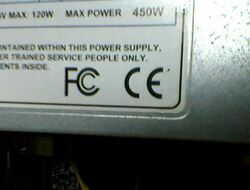Engineering:FCC Declaration of Conformity
| FCC Declaration of Conformity | |
|---|---|
 The 'Declaration of Conformity' label | |
| Standards organization | Federal Communications Commission |
| Effective region | United States |
| Product category | Electronic equipment. |
| Legal status | Mandatory |
The FCC Declaration of Conformity[1] or the FCC label or the FCC mark is a certification mark employed on electronic products manufactured or sold in the United States which certifies that the electromagnetic interference from the device is under limits approved by the Federal Communications Commission.[1][2][3][4][5][6][7] The FCC label is found even on products sold outside the US territory, because they are either products manufactured in the US and had been exported, or they are also sold in the US. This makes the FCC label recognizable worldwide even to people to whom the name of the agency Federal Communications Commission is not familiar.[8][9]
Formerly, devices classified under part 15 or part 18 of the FCC regulations were required to be labelled with the FCC mark, but in November 2017 the mark was made optional. Devices must still be accompanied by a Supplier's Declaration of Conformity.[10]
Overview
The Federal Communications Commission established the regulations on electromagnetic interference under Part 15 of the FCC rules in 1975. After several amendments over the years, these regulation were reconstituted as the Declaration of Conformity and Certification procedures in 1998.
By the regulation, the FCC DoC certification mark is mandatory for devices classified under part 15 (IT equipment like computers, switched-mode power supplies, monitors etc., television receivers, cable system devices, low-power transmitters, un-licensed personal communication devices) and part 18 (industrial, scientific, and medical (ISM) devices that emit RF radiation) of the FCC regulations.
The certification mark is a stand-alone logo (as shown above) for the part 18 class of devices while, for the part 15 class, along with the logo, the label should display other data viz, the trade name of the product, the model number, and information whether the device was tested after assembling, or assembled from tested components.[2][11]
As of January 2012, there are 279 test firms worldwide, accredited with the Commission who are qualified to issue the declaration of conformity certificate.[12]
Even though most of the nations exporting electronic equipment into the US market have their own standards for EMI as well as independent certification and conformity marks (e.g.: The CCC certification mark for China , the VCCI (Voluntary Council for Control of Interference) mark for Japan , the KC mark by the Korea Communications Commission for South Korea , the ANATEL mark for Brazil , and the BSMI mark for Taiwan), most of the products still sold in these markets hold the FCC label. Electronic products sold in parts of Asia and Africa hold the FCC label even though it holds no legal significance, and also without any means to verify whether they actually conform to the specified standards or not.[citation needed]
Canada's regulating body is called Innovation, Science and Economic Development Canada (ISED) - formally Industry Canada (IC). Products sold in Canada may have the FCC declaration and/or the CE declaration, however, neither declaration has any legal significance in Canada.
See also
- CE mark
- Energy Star
- Title 47 CFR Part 15
References
- ↑ 1.0 1.1 Federal Communications Commission. FCC ID Help.
- ↑ 2.0 2.1 Compliance Engineering magazine. 'Inside FCC Part 15 and Canada's Corresponding Standards By Roland W. Gubisch'.
- ↑ Federal Communications Commission. FCC-Approved Equipment Authorization Labels.
- ↑ Federal Communications Commission. FCC-Approved Equipment Labels for Part 15 and Part 18 devices. Labelling guidelines, user information requirements and print-resolution labels.
- ↑ i-spec.com. EMC requirements for USA.
- ↑ Percept.com Global certification.
- ↑ National Instruments. Product certification details.
- ↑ Smokinapps.com 'What do the symbols on the back of the iPhone mean?'
- ↑ TÜV SÜD. 'FCC Certification.'
- ↑ 82 FR 50830
- ↑ Federal Communications Commission, Office of Engineering and Technology. 'Understanding The Fcc Regulations For Low-Power, Non-Licensed Transmitters'.
- ↑ Federal Communications Commission. Equipment Authorization System Test Firms.



